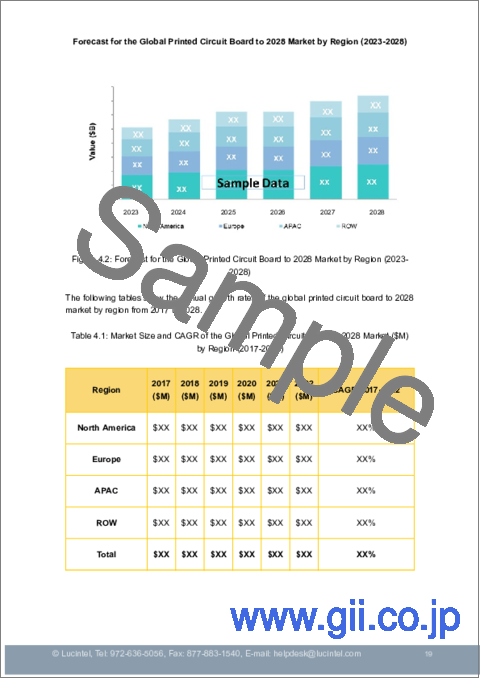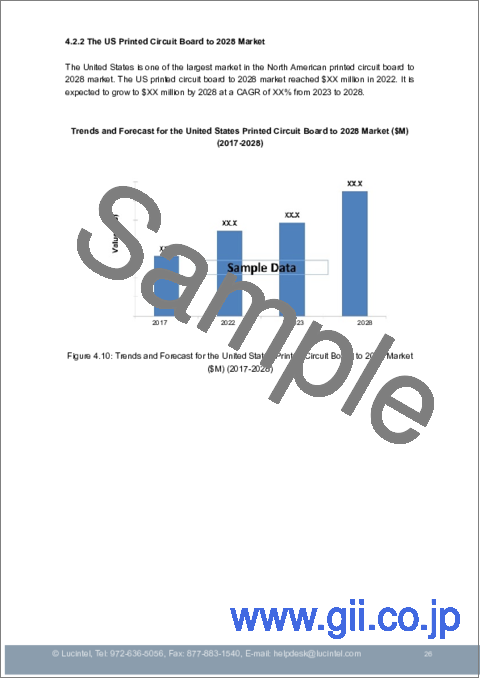|
|
市場調査レポート
商品コード
1263986
プリント基板(PCB)の世界市場:動向、機会、競合分析(~2028年)Printed Circuit Board Market Forecast to 2028: Global Trends, Opportunities and Competitive Analysis |
||||||
|
● お客様のご希望に応じて、既存データの加工や未掲載情報(例:国別セグメント)の追加などの対応が可能です。 詳細はお問い合わせください。 |
|||||||
| プリント基板(PCB)の世界市場:動向、機会、競合分析(~2028年) |
|
出版日: 2023年03月01日
発行: Lucintel
ページ情報: 英文 229 Pages
納期: 3営業日
|
- 全表示
- 概要
- 目次
世界のプリント基板(PCB)の市場規模は、2028年には1,077億米ドルになると予測されており、2023年から2028年までの予測期間中のCAGRは4.3%となっています。通信産業におけるPCB需要の増加、コネクテッドデバイスの成長、カーエレクトロニクスの成長は、市場の成長を促進しています。
当レポートでは、世界のプリント基板(PCB)市場について調査しており、市場力学、市場動向、企業プロファイルなど、包括的な情報を提供しています。
目次
第1章 エグゼクティブサマリー
第2章 市場の背景と分類
- イントロダクション、背景、分類
- サプライチェーン
- 産業の促進要因と課題
第3章 市場動向と予測分析(2017年~2028年)
- マクロ経済の動向(2017年~2022年)と予測(2023年~2028年)
- 世界のプリント基板(PCB)市場の動向(2017年~2022年)と予測(2023年~2028年)
- 世界のプリント基板(PCB)市場:最終用途産業別
- コンピュータ・周辺機器
- 通信
- 家電
- 産業用電子機器
- 自動車
- 軍事・航空宇宙
- その他
- 世界のプリント基板(PCB)市場:製品タイプ別
- リジッド1-2両面
- 標準多層
- HDI・マイクロビア・ビルドアップ
- IC基板
- リジッドフレックス
- フレキシブル回路
- その他
- 世界のプリント基板(PCB)市場:材料別
- FR-4
- フレキシブル
- 紙
- CEM
- その他
- 世界のプリント基板(PCB)市場:原材料別
- ガラス繊維
- エポキシ樹脂
- クラフトペーパー
- フェノール樹脂
- ポリイミドフィルム
第4章 市場動向と予測分析(2017年~2028年):地域別
- 世界のプリント基板(PCB)市場:地域別
- 北米のプリント基板(PCB)市場
- 欧州のプリント基板(PCB)市場
- アジア太平洋のプリント基板(PCB)市場
- その他のプリント基板(PCB)市場
第5章 競合の分析
- 製品ポートフォリオ分析
- 市場シェア分析
- 運用統合
- 地理的範囲
- ポーターのファイブフォース分析
第6章 成長機会と戦略分析
- 成長機会分析
- 世界のプリント基板(PCB)市場の成長機会:最終用途産業別
- 世界のプリント基板(PCB)市場の成長機会:製品タイプ別
- 世界のプリント基板(PCB)市場の成長機会:地域別
- 世界のプリント基板(PCB)市場の新たな動向
- 戦略分析
- 世界のプリント基板(PCB)市場における新製品開発
- 世界のプリント基板(PCB)市場における生産能力拡大
- 世界のプリント基板(PCB)市場における認証とライセンシング
- 世界のプリント基板(PCB)市場における合併と買収
- 世界のプリント基板(PCB)市場における技術開発
第7章 主要企業プロファイル
- NOK Corporation
- Zhen Ding Technology
- TTM Technologies
- Unimicron Technology
- Compeq Manufacturing
- Young Poong Electronics
- Ibiden
- Samsung Electro-Mechanics
- Tripod Technology
- Daeduck GDS
- Nan Ya Printed Circuit Board Corporation
- AT&S
PCB Market Trends and Forecast
The future of the global printed circuit board (PCB) market looks promising with opportunities in the computer/peripherals, communications, consumer electronics, industrial, automotive, and military/aerospace industries. The global printed circuit board (PCB) market is expected to reach an estimated $107.7 billion by 2028 with a CAGR of 4.3% from 2023 to 2028. The major drivers for this market are increasing demand for PCB in the communication industry, growth in connected devices, and growth in automotive electronics.
Emerging Trends in the PCB Market
Emerging trend, which has a direct impact on the dynamics of the industry, includes miniaturization of printed circuit boards, growing demand for high speed data and signal transmission, and development of green PCBs. NOK Corporation, Zhen Ding Technology, TTM Technologies, Unimicron Technology, Compeq Manufacturing, Young Poong Electronics, and Ibiden are among the major manufacturers of PCBs.
A total of 137 figures / charts and 117 tables are provided in this 229-page report to help in your business decisions. Sample figures with insights are shown below.
PCB Market by Segments
In this market, computers/peripherals will remain the largest end use industry. The study includes trends and forecasts for the global printed circuit board (PCB) market by end use industry, product type, material, raw material usage, and region as follows:
PCB Market by End Use Industry [Value ($B) and Volume (M Sqm) shipment analysis for 2017 - 2028]:
- Computers/Peripherals
- Communications
- Consumer Electronics
- Industrial Electronics
- Automotive
- Military/Aerospace
- Others
PCB Market by Product Type [Value ($B) and Volume (M Sqm) shipment analysis for 2017 - 2028]:
- Rigid 1-2 Sided
- Standard Multilayer
- HDI/Microvia/Build-Up
- IC Substrate
- Rigid-Flex
- Flexible Circuits
- Others
PCB Market by Laminate Materials Type [Value ($M) shipment analysis for 2017 - 2028]:
- FR-4
- FR-4 high Tg
- FR-4 halogen free
- Standard & Others
- Flexible (PI,PET)
- Paper
- Composites
- Others
PCB Market by Raw Material Usage [Value ($B) and Volume (M sqm) shipment analysis for 2017 - 2028]:
- Glass Fabric
- Epoxy Resin
- Kraft Paper
- Phenolic Resin
- Polyimide Film
PCB Market by Region [Value ($M) and Volume (M lbs) shipment analysis for 2017 - 2028]:
- North America
- USA
- Mexico
- Canada
- Europe
- Germany
- UK
- France
- Asia Pacific
- China
- Taiwan
- India
- Japan
- South Korea
- The Rest of the World
List of PCB Companies
Companies in the market compete on the basis of product quality offered. Major players in this market focus on expanding their manufacturing facilities, R&D investments, infrastructural development, and leverage integration opportunities across the value chain. With these strategies, PCB companies cater to increasing demand, ensure competitive effectiveness, develop innovative products & technologies, reduce production costs, and expand their customer base. Some of the PCB companies profiled in this report include-
- NOK Corporation
- Zhen Ding Technology
- TTM Technologies
- Unimicron Technology
- Compeq Manufacturing
- Young Poong Electronics
- Ibiden
- SEMCO
- Tripod Technology
- Daeduck
- AT&S
- Nan Ya Printed Circuit Board
PCB Market Insights
- Lucintel forecasts that standard multilayers will remain the largest product type due to increasing demand in computer and communication industries.
- Communication will remain the largest end use industry during the forecast period due to growing e-communication. The automotive segment is expected to witness the highest growth due to the increasing demand for electric and hybrid vehicles.
- Asia Pacific is expected to remain the largest market and witness the highest growth over the forecast period due to the increasing electronic content in automotive, and growth in consumer electronic devices and telecommunication products. Increasing usage of electric vehicles due to growing environmental concerns and regulations is also expected to drive the demand for PCB in this region.
Features of the Printed Circuit Board (PCB) Market
- Market Size Estimates: Printed Circuit Board (PCB) market size estimation in terms of value ($M)
- Trend And Forecast Analysis: Market trends (2017-2022) and forecast (2023-2028) by various segments and regions.
- Segmentation Analysis: Printed circuit board (PCB) market size by various segments, such as end use industry, product type, material, raw material usage in terms of value.
- Regional Analysis: Printed circuit board (PCB) market breakdown by North America, Europe, Asia Pacific, and the Rest of the World.
- Growth Opportunities: Analysis on growth opportunities in different end use industry, product type, material, raw material usage, and regions for the printed circuit board (PCB) market.
- Strategic Analysis: This includes M&A, new product development, and competitive landscape for the printed circuit board (PCB) market.
- Analysis of competitive intensity of the industry based on Porter's Five Forces model.
FAQ
Q1. What is the PCB market size?
Answer: The global PCB market is expected to reach an estimated $107.7 billion by 2028.
Q2. What is the growth forecast for PCB market?
Answer: The global PCB market is expected to grow with a CAGR of 4.3% from 2023 to 2028.
Q3. What are the major drivers influencing the growth of the PCB market?
Answer: The major drivers for this market are increasing demand for PCB in the communication industry, growth in connected devices, and growth in automotive electronics.
Q4. What are the major applications or end use industries for PCB?
Answer: The future of the printed circuit board (PCB) market looks promising with opportunities in the computer/peripherals, communications, consumer electronics, industrial, automotive, and military/aerospace industries.
Q5. What are the emerging trends in PCB market?
Answer: Emerging trend, which has a direct impact on the dynamics of the industry, includes miniaturization of printed circuit boards, growing demand for high speed data and signal transmission, and development of green PCBs.
Q6. Who are the key PCB companies?
Answer: Some of the key PCB companies are as follows:
- NOK Corporation
- Zhen Ding Technology
- TTM Technologies
- Unimicron Technology
- Compeq Manufacturing
- Young Poong Electronics
- Ibiden
- SEMCO
- Tripod Technology
- Daeduck
- AT&S
- Nan Ya Printed Circuit Board
Q7. Which PCB segment will be the largest in future?
Answer:Lucintel forecasts that standard multilayers will remain the largest product type due to increasing demand in computer and communication industries.
Q8. In PCB market, which region is expected to be the largest in next 5 years?
Answer: Asia Pacific is expected to remain the largest market and witness the highest growth over the forecast period due to the increasing electronic content in automotive, and growth in consumer electronic devices and telecommunication products. Increasing usage of electric vehicles due to growing environmental concerns and regulations is also expected to drive the demand for PCB in this region.
Q9. Do we receive customization in this report?
Answer: Yes, Lucintel provides 10% Customization Without any Additional Cost.
This report answers following 11 key questions
- Q.1 What are some of the most promising potential, high-growth opportunities for the global printed circuit board (PCB) market by end use industry (computer/peripheral, communication, consumer electronics, industrial electronics, automotive, military/aerospace, and others), product type (standard multilayer, flexible circuits, HDI/microvia/build-up, IC substrate, rigid 1-2 sided, rigid flex, and others), laminate material type (FR-4, flexible, paper, CEM and others), laminate raw material usage (glass fabric, epoxy resin, kraft paper, phenolic resin, and polyimide film), and region (North America, Europe, Asia Pacific, and the Rest of the World)?
- Q.2 Which segments will grow at a faster pace and why?
- Q.3 Which regions will grow at a faster pace and why?
- Q.4 What are the key factors affecting market dynamics? What are the drivers and challenges of the Printed Circuit Board (PCB) market?
- Q.5 What are the business risks and threats to the printed circuit board (PCB) market?
- Q.6 What are emerging trends in the printed circuit board (PCB) market and the reasons behind them?
- Q.7 What are some changing demands of customers in the printed circuit board (PCB) market?
- Q.8 What are the new developments in the printed circuit board (PCB) market? Which companies are leading these developments?
- Q.9 Who are the major players in the printed circuit board (PCB) market? What strategic initiatives are being implemented by key players for business growth?
- Q.10 What are some of the competitive products and processes in the printed circuit board (PCB) market, and how big of a threat do they pose for loss of market share via material or product substitution?
- Q.11 What M&A activities did take place in the last five years in the printed circuit board (PCB) market?
- Report Scope
- Key Features Description
- Base Year for Estimation 2023
- Trend Period
- (Actual Estimates) 2017-2022
- Forecast Period 2023-2028
- Pages 229
- Market Representation / Units Revenue in US $ Million
- Report Coverage Market Trends & Forecasts, Competitor Analysis, New Product Development, Company Expansion, Merger Acquisitions & Joint Venture, and Company Profiling
- Market Segments End Use Industry (Computer/Peripheral, Communication, Consumer Electronics, Industrial Electronics, Automotive, Military/Aerospace, and Others), Product Type (Standard Multilayer, Flexible Circuits, HDI/Microvia/Build-Up, IC Substrate, Rigid 1-2 Sided, Rigid Flex, and Others), Laminate Material Type (FR-4, Flexible, Paper, CEM and Others), and Laminate Raw Material Usage (Glass Fabric, Epoxy Resin, Kraft Paper, Phenolic Resin, and Polyimide Film)
- Regional Scope North America, Europe, Asia Pacific, and ROW
- Customization 10% Customization Without any Additional Cost
Table of Contents
1. Executive Summary
2. Market Background and Classifications
- 2.1: Introduction, Background, and Classifications
- 2.2: Supply Chain
- 2.3: Industry Drivers and Challenges
3. Market Trends and Forecast Analysis from 2017 to 2028
- 3.1: Macroeconomic Trends (2017-2022) and Forecast (2023-2028)
- 3.2: Global Printed Circuit Board (PCB) Market Trends (2017-2022) and Forecast (2023-2028)
- 3.3: Global Printed Circuit Board (PCB) Market by End Use Industry
- 3.3.1: Computer/Peripheral
- 3.3.2: Communication
- 3.3.3: Consumer Electronics
- 3.3.4: Industrial Electronics
- 3.3.5: Automotive
- 3.3.6: Military/Aerospace
- 3.3.7: Others
- 3.4: Global Printed Circuit Board (PCB) Market by Product Type
- 3.4.1: Rigid 1-2 Sided
- 3.4.2: Standard Multilayer
- 3.4.3: HDI/Microvia/Build-Up
- 3.4.4: IC Substrate
- 3.4.5: Rigid Flex
- 3.4.6: Flexible Circuits
- 3.4.7: Others
- 3.5: Global Printed Circuit Board (PCB) Market by Material
- 3.5.1: FR-4
- 3.5.2: Flexible
- 3.5.3: Paper
- 3.5.4: CEM
- 3.5.5: Others
- 3.6: Global Printed Circuit Board (PCB) Market by Raw Material Usage
- 3.6.1: Glass Fabric
- 3.6.2: Epoxy Resin
- 3.6.3: Kraft Paper
- 3.6.4: Phenolic Resin
- 3.6.5: Polyimide Film
4. Market Trends and Forecast Analysis by Region from 2017 to 2028
- 4.1: Global Printed Circuit Board (PCB) Market by Region
- 4.2: North American Printed Circuit Board (PCB) Market
- 4.2.1: Market by End Use Industry
- 4.2.2: Market by Product Type
- 4.2.3: United States Printed Circuit Board (PCB) Market
- 4.2.4: Canadian Printed Circuit Board (PCB) Market
- 4.2.5: Mexican Printed Circuit Board (PCB) Market
- 4.3: European Printed Circuit Board (PCB) Market
- 4.3.1: Market by End Use Industry
- 4.3.2: Market by Product Type
- 4.3.3: German Printed Circuit Board (PCB) Market
- 4.3.4: French Printed Circuit Board (PCB) Market
- 4.3.5: United Kingdom Printed Circuit Board (PCB) Market
- 4.4: APAC Printed Circuit Board (PCB) Market
- 4.4.1: Market by End Use Industry
- 4.4.2: Market by Product Type
- 4.4.3: Chinese Printed Circuit Board (PCB) Market
- 4.4.4: Japanese Printed Circuit Board (PCB) Market
- 4.4.5: Indian Printed Circuit Board (PCB) Market
- 4.4.6: Taiwan Printed Circuit Board (PCB) Market
- 4.4.7: South Korean Printed Circuit Board (PCB) Market
- 4.5: ROW Printed Circuit Board (PCB) Market
- 4.5.1: Market by End Use Industry
- 4.5.2: Market by Product Type
5. Competitor Analysis
- 5.1: Product Portfolio Analysis
- 5.2: Market Share Analysis
- 5.3: Operational Integration
- 5.4: Geographical Reach
- 5.5: Porter's Five Forces Analysis
6. Growth Opportunities and Strategic Analysis
- 6.1: Growth Opportunity Analysis
- 6.1.1: Growth Opportunities for the Global Printed Circuit Board (PCB) Market by End Use Industry
- 6.1.2: Growth Opportunities for the Global Printed Circuit Board (PCB) Market by Product Type
- 6.1.3: Growth Opportunities for the Global Printed Circuit Board (PCB) Market by Region
- 6.2: Emerging Trends in the Global Printed Circuit Board (PCB) Market
- 6.3: Strategic Analysis
- 6.3.1: New Product Development in the Global Printed Circuit Board (PCB) Market
- 6.3.2: Capacity Expansion in the Global Printed Circuit Board (PCB) Market
- 6.3.3: Certification and Licensing in the Global Printed Circuit Board (PCB) Market
- 6.3.4: Mergers and Acquisitions in the Global Printed Circuit Board (PCB) Market
- 6.3.5: Technology Development in the Global Printed Circuit Board (PCB) Market
7. Company Profiles of Leading Players
- 7.1: NOK Corporation
- 7.2: Zhen Ding Technology
- 7.3: TTM Technologies
- 7.4: Unimicron Technology
- 7.5: Compeq Manufacturing
- 7.6: Young Poong Electronics
- 7.7: Ibiden
- 7.8: Samsung Electro-Mechanics
- 7.9: Tripod Technology
- 7.10: Daeduck GDS
- 7.11: Nan Ya Printed Circuit Board Corporation
- 7.12: AT&S




